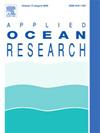Response surface method-based efficient approach for the load and resistance factors calibration of breakwater foundation considering soil spatial variability
Abstract
This study aims to propose an efficient approach to calibrate the load and resistance factors (LRFs) for the limit state design of breakwater foundations. The spatial variability of soil was considered by employing the Cholesky decomposition technique. To overcome the low computational efficiency of the Monte Carlo simulation (MCS), a response surface method (RSM) was utilized. Additionally, an efficient algorithm, namely the adaptive boundary-based particle filtering algorithm (ABB-PFA), was proposed with the use of RSM to automatically and quickly search optimal nominal values of random variables in the LRF calibration process. Noticeably, the optimal number of particles and values of the modification factor used in the ABB-PFA were observed to enhance the efficiency of the calibration process. The results showed that the computational efficiency of the calibration process is significantly increased by utilizing the response surface method and the proposed ABB-PFA. The efficiency increases the most if the number of particles is one and the value of the modification factor is 0.5 or 0.6. The influences of the random field element size on the efficiency of the calibration process were also investigated. By using the appropriate size, the efficiency is significantly increased while still obtaining a high accuracy of the LRFs calibration process.

 求助内容:
求助内容: 应助结果提醒方式:
应助结果提醒方式:


